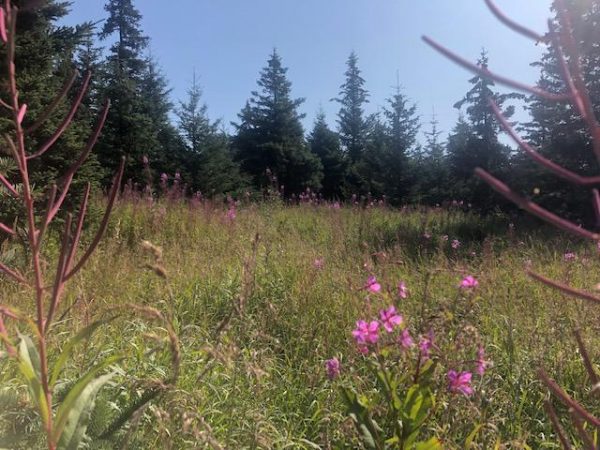
The Kenai Peninsula is drying out and this summer, fires have sprouted up in some unusual places. Scientists warn about this trend: meaning bigger fires and more of them.
Ed Berg is digging a roughly foot-wide-hole in a wetland off Diamond Creek Trail in Homer. He’s a retired ecologist from the Kenai National Wildlife Refuge.
“So what I’m seeing in the plug are all these little woody roots that are from the crowberry and the dwarf birch drawers, and blueberry,” Berg said.
These roots are an indication of a profound change. For thousands of years, peninsula wetlands didn’t see any woody shrubs like these.
“Within the last 50 years or so, the woody plants have come in gangbusters and starting even earlier with some of the trees like black spruce, which are very moisture tolerant, especially since the 1970s, we’ve seen these shrubs come in,” Berg said.
He said these plants are sprouting up because of warmer temperatures and less precipitation. And as a whole, wetlands across the peninsula are just less wet.
Now some places were you used to need rubber boots in the wetlands, you can get by with just tennis shoes. That might be a nice change for hiking. But not so for stopping fires, which wetlands usually do.
“The fire just would burn up to the edge and wouldn’t normally burn across it,” Berg said. “Now these firebreaks are being turned into what you might call fire bridges.”
But wetlands aren’t the only landscapes changing. Essentially all the water stored in the soil has declined by roughly 60 percent on the Kenai Peninsula. Drying out not just wetlands, but grasslands too.
“Well, what’s changing now with the climates we’re getting is that spring window is getting a little bit longer, where are you have this exposure of dried grass on top of the ground there, so that’s getting longer,” said Kenai National Wildlife Refuge Supervisory Biologist John Morton.
So here on the peninsula, which is used to seeing summer forest fires, spring grassland fires are likely to become more common.
“This year, of course, we had two fires up in Caribou Hills that started in grassland and what was so unusual about them is that these are the first fires that I’m aware of where they were actually caused by lightning in early June in a grassland situation on the Kenai,” Berg said.
That brings us to another big shift: warmer weather is bringing early summer and late spring storms… with lightning. And lightning plus dry grass is a perfect recipe for fires.
Scott Rupp is the deputy director of the International Arctic Research Center at the University of Alaska Fairbanks. He said the number of lightning strikes happening in Alaska is unprecedented. Most strikes aren’t starting fires. But the ones that do are often hard to put out.
“We tend to be really good at putting out those fires that we start partly because we tend to start them in populated areas, and we have resources available to very quickly jump on those” Rupp said. “Where as lightning is occurring all over the landscape and many times in very remote areas.”
Back at Diamond Creek Trail, Ed Berg said fire safety is something he wants residents here to think about. Even if they live by a wetland.
“They may think they’re protected if they have muskeg growing on all sides of their house” Berg said. “But in the next 20 years, that muskeg may turn into a spruce woodland and they won’t be as protected.”
He said residents should be prepared for the change.




